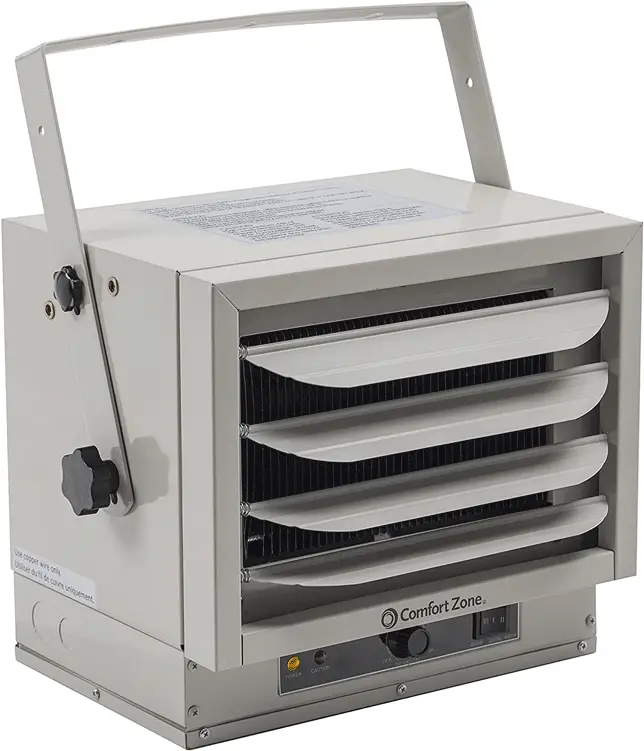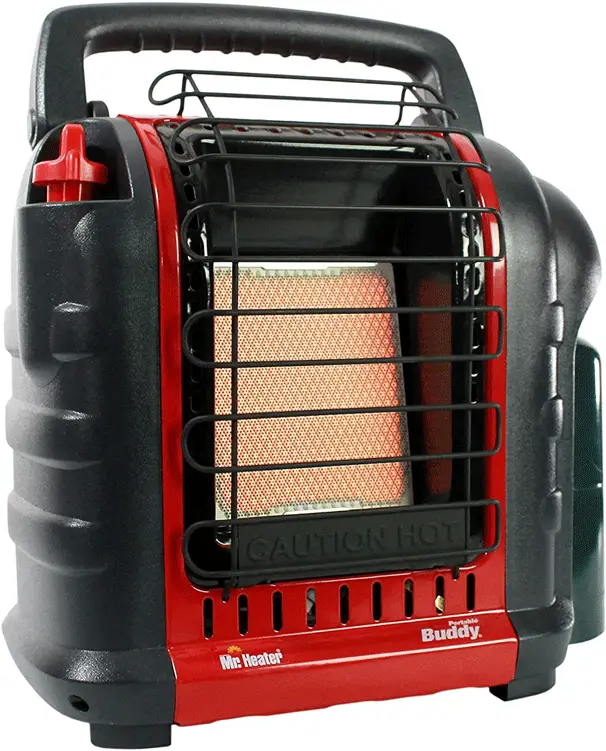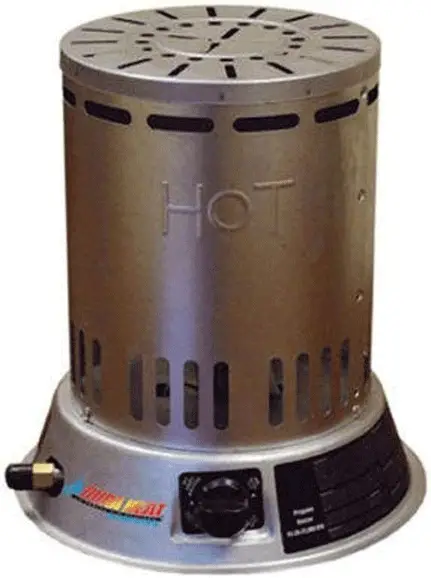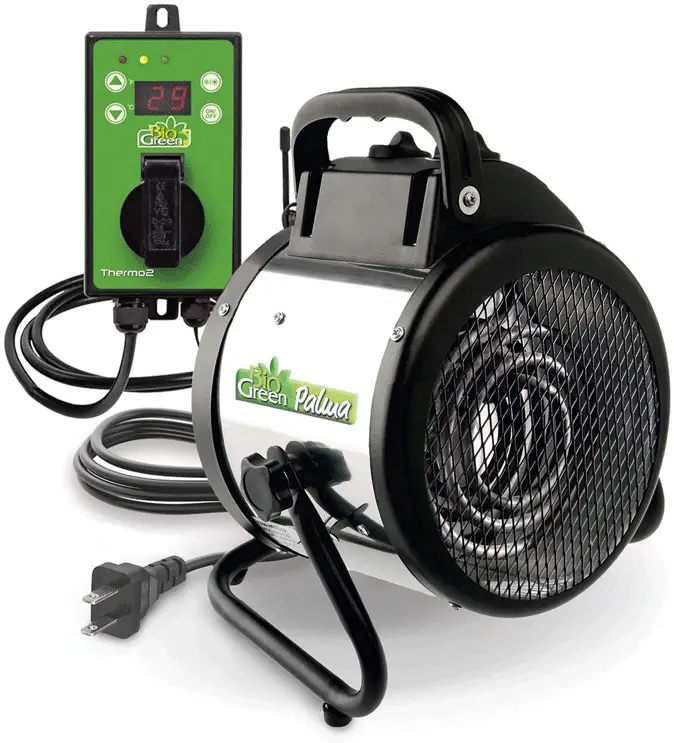Best Greenhouse Heaters

This post follows our research editorial guidelines.

While the inside of a greenhouse is naturally warmer than the outside temperatures, the cold weather requires a heating boost from time to time.
A good greenhouse heater coupled with temperature control systems also boosts air circulation during summertime. With these perfect conditions you can expect some serious improvements in the size and quality of your greenhouse plants.
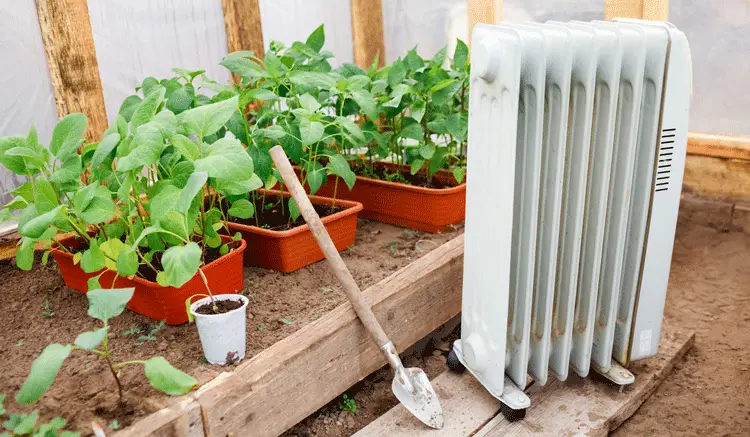
Attention Garden Lovers: This post contains handpicked links to recommended gardening products. If you buy something through these links, I may earn a small commission at no extra cost to you.
Table of Contents
However, with no heat in the winters, I would say the best option is a greenhouse heater!
Greenhouse heaters also protect plants from frost during winter by maintaining optimal temperature and minimizing humidity. These are especially important for vegetable and tropical plants that are better suited to warmer conditions.
I would also suggest insulating your greenhouse before using a greenhouse heater to keep the hot air. Horticultural bubble wrap or fleece can be used in layers for insulation during those cold windy months.
“The heat of autumn is different from the heat of summer. One ripens apples, the other turns them to cider.”
Jane Hirshfield states
BTUs
Deciding on the best greenhouse heater can be quite a task.
Before you do, you must know how big or strong a heater you’ll need. The number of BTUs (British Thermal Units) helps determine how strong the appliance must be to heat a space.
Calculating BTU is based on the amount of heat for raising the temperature of a pound of water by one degree Fahrenheit.
Based on the cubic feet of greenhouse space and the desired temperature rise needed (the difference between the lowest outside and desired inside temperatures), the number of BTUs will help decide which heater will be sufficient.
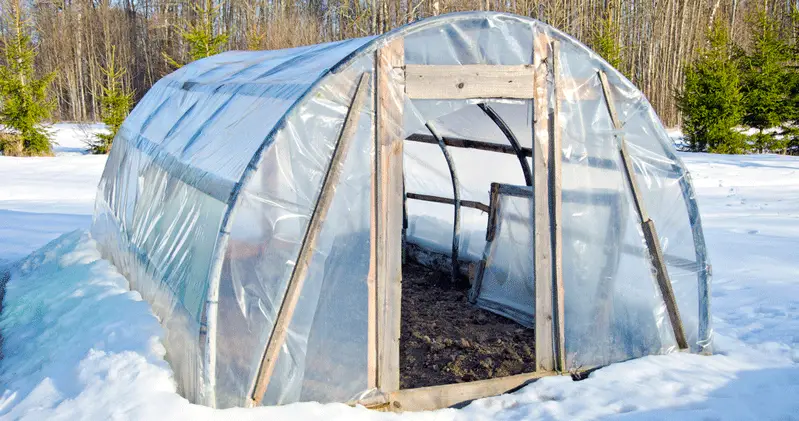
Electric Greenhouse Heater
For installing an electric heater in your greenhouse, you’ll need to have a power supply.
A safety trip switch on the fuse board is also necessary to link the electric mains to the greenhouse. You could regulate the temperature yourself or add a thermostat to these heaters.
Electric heaters are available as infrared heaters and convective heaters. Some fan-assisted models radiate heat to specific areas.
The budget-friendly and energy-efficient infrared or radiant heaters directly heat certain objects or parts of the room (not the air), warming the surrounding air.
Convective or forced air heaters have a short recovery time and are great with programmable thermostats. Don’t forget to keep all doors and windows closed to prevent hot air from escaping outside.
Comfort Zone 5000W Fan-Forced Heater
Save some floor space in your greenhouse with this ceiling-mount heater. While it provides targeted heating, the fan-forced technology ensures even heat distribution.
Along with an adjustable thermostat, there are 3 heat settings to choose from – 3,000, 4,000, and 5,000W. It requires a hard-wired 208V or 240V connection and works at 17,070 BTU.
Pros
- Saves floor space
- Heavy-duty and durable, with its heavy gauge steel body
- Withstands temperature fluctuations in poorly insulated areas
- Easy temperature control with the dual knobs
- Variable mounting angle to direct airflow as needed
- Built-in sensor to auto shut off when overheating
- Removable front grille assembly for easy cleaning
- Power light to indicate when the heater is in use
Cons
- The fan blades are poorly assembled and get loose eventually.
- The noise from the fan rattling tends to be annoyingly loud.
Lasko Ceramic Space Heater 754200
With ceramic heaters, regulating your greenhouse temperature during winter can be effectively done. This device has an adjustable thermostat, making it easy to control the temperature inside, to suit the needs of your plants.
The heating method of the Lasko ceramic heater is forced air and convection, and it contains a self-regulating ceramic element.
Pros
- An adjustable thermostat makes for easy adjustment of the 1500W ceramic heating element.
- 3 quiet settings – fan only, low heat, and high heat
- 11 different temperature settings to suit any desired heat settings
- Portable due to its convenient carry handle and compact size
- Automatic overheat protection
- Cool-touch exterior keeps the heater’s body cool even when operating on high heat.
Cons
- No remote control
- If accidentally tipped over, there is no auto shut-off feature.
- Fire hazard with possibilities if not properly handled
AirNmore Comfort Deluxe Infrared Space Heater 1500W
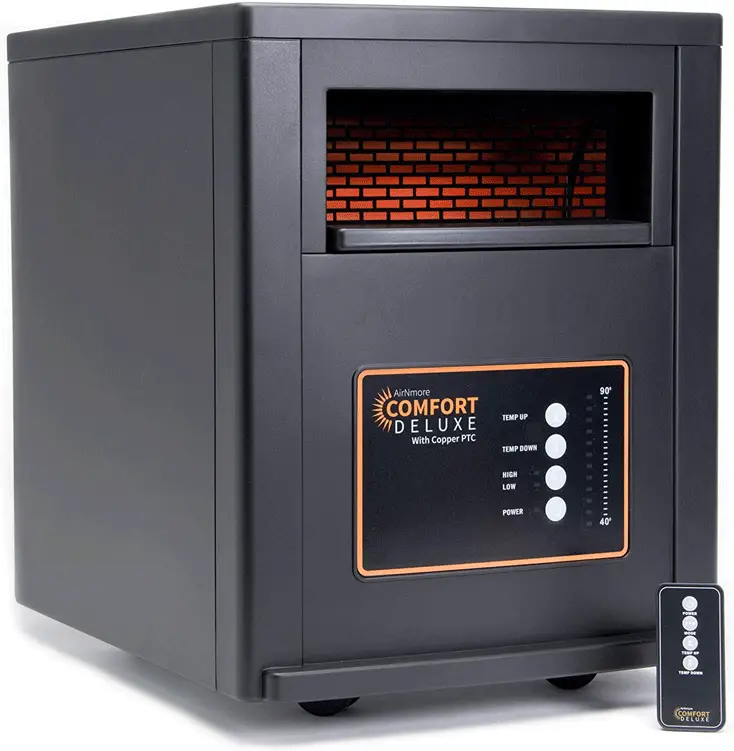
Don’t worry if you have a small greenhouse; this reliable infrared zone heater is ideal for small to large spaces.
With a copper PTC heating element instead of aluminum, there’s no need to bother about any heating element bulbs burning out. It can efficiently heat about 1000 square feet of space. That’s really good heating!
Pros
- No replacement of heating element bulbs is needed because of copper PTC.
- Dual heat sensors keep high temperatures limited.
- Even at high-temperature operation, the unit stays cool to the touch.
- Advanced tip-over protection with safety sensors; safe to use around children and pets
- Contains a heavy-duty particle filter that protects the internal components
- High-quality casters enable ease of portability.
- Remote control for conveniently operating the heater
Cons
- The thermostat cuts off the heating before it gets sufficiently hot.
- Makes loud sound
- Expensive
Solar Greenhouse Heater
If you’d like to go green for your greenhouse heating needs, solar panels are the way to go!
They build an artificial environment to sustain plants with low temperatures outside. Maintaining a steady temperature throughout the year, these environment-friendly devices retain optimum heat for your plants to thrive.
With a battery hooked up to the solar panel system, energy can be stored during the day that a heating device can use during the night or on cold and less sunny days.
These can help cut down your electricity bills. That, in my opinion, is quite impressive, considering how much I need to shell out for heating during the winter.
Renogy 100W 12V Monocrystalline Solar Panel Kit
This solar power kit is ideal for those who are getting started with solar heating. With about 4 hours of sunlight availability, daily output of 400Wh can be achieved.
It is suitable for a small footprint and provides an output voltage of 12V.
Pros
- The corrosion-resistant aluminum frame makes the panel long-lasting.
- Easy to install owing to the pre-drilled holes and plug-and-play cables at the back
- The 30A PWM Renogy Wanderer-Li battery solar charge controller increases battery life and improves system performance.
- 3 types of 12 V batteries are supported: lithium, lead-acid, or gel batteries.
- 5-year warranty
- Prevention of the battery’s over-charge, discharge and short circuit, over-voltage, and reversed polarity protection
- Quiet power production
- A negative grounding controller ensures the safety and broader off-grid applications.
Cons
- If the wires aren’t carefully inserted into the battery charge controller, the connection breaks easily.
- The solar panel wires aren’t labeled as + and – on both ends of the wire, making installation slightly confusing.
- The regulator doesn’t hold the cables securely; if moved, they get loose.
Eco-Worthy 120W Foldable Solar Panel
This lightweight solar panel can generate 500Wh daily with about 4 hours of direct sunlight.
Since this works on solar energy to help store power, it works great if there are unexpected power outages (winters do bring annoyingly long outages at times).
This is the upgraded 120W solar panel, and when multiple panels are used, more power is available to make your greenhouse heaters last longer, as required.
Pros
- Extremely lightweight; weighs only 9 pounds (4.2 kg)
- The 20A built-in LCD solar charge controller protects from overcharge and reduces fire risk.
- A 3-meter cable provides convenient connections.
- 2 tilting kickstands (built-in) enable 25% more solar energy absorption.
- 10 different connectors can be used to charge multiple generator types.
- With the controller, the 12V battery can be charged using alligator clips.
Cons
- Expensive
- When connected to the solar generator, the USB port and controller display don’t work.
- Charging doesn’t work when t.he battery is under over-discharge protection until the voltage gets to 12.6V.
Gas/Propane Heater
Not requiring electricity, gas heaters can be used individually or in groups, without cables. Propane comes in tanks, and unlike natural gas, it isn’t harmful to the environment.
This way, you save on electricity, but you’ll still have to stock up on the gas supply. Although these heaters are less effective than electric heaters, in the long run, they’re more affordable.
You’ll need to ensure an adequate supply of propane and spare wicks to suffice when you wish to heat your greenhouse. Also, there needs to be sufficient ventilation when using gas heaters.
Mr. Heater F232000 MH9BX Buddy Propane Heater
Considered among the best gas greenhouse heaters, this radiant heater of 4,000 – 9,000 BTU efficiently heats up to 225 square feet of space.
With the fold-down handle and a swivel-out regulator, the propane tank can be connected, providing a run-time of 3 hours at maximum BTU. On average, it runs for 5.4 hours on the low setting and 2.4 hours on the high setting.
Pros
- Clean burning and almost 100% efficient
- There is an auto shut-off feature when low oxygen levels are detected, if it tips over, or when the pilot light turns off.
- Easy-grip handle for portability
- Heavy-duty design and wire guard
- Swivel regulator can be used for disposable cylinder or remote gas supply (needs a hose and filter)
Cons
- The propane cylinder is not included with the product’s purchase
- Propane supply must be ensured for unhindered operation
- Can cause increased CO2 and CO levels
Dura Heat LPC25 Propane Convection Heater
Ideal for greenhouse gardening needs during the winters, this propane-powered heater can efficiently heat up to 600 square feet of space. This 15,000 – 25,000 BTU heater works with the convection heating method.
With a 20 lb. propane gas cylinder, it can operate for up to 28 hours.
Pros
- With a 360-degree output, heat is distributed in all directions.
- Simple operation
- Auto-safety shut off
- Comes with a 10 feet hose and regulator for convenient use
- For a smaller greenhouse, it raises the temperature by 10 degrees in 5 minutes.
Cons
- A propane tank isn’t included.
- On full blast heating, it’s a bit loud.
- Most of the heat funnels out vertically than horizontally.
Best Small Greenhouse Heater
Don’t worry if you have a small greenhouse and want to heat it without having to spend much.
For heating a small greenhouse and keeping it frost-free, you don’t need to go for a heavy-duty heater. Instead, there are heaters made explicitly for small greenhouse heating.
Bio Green PAL 2.0/USDT Palma Greenhouse Heater
The Bio Green heater is a small electric greenhouse heater that is effective, portable, and heats about 120 square-feet space efficiently.
Being a fan-powered heater, it provides good circulation and helps maintain the heat consistently in the greenhouse; it also removes cold air pockets.
With a heating power of 5118 BTU and an output of 1500W, an air circulation of up to 460 cubic meters per hour is achieved.
The dual function capacity of this device makes it appropriate to use in the summer for air circulation as well, which is essential for the pollination of flowers and vegetables.
Pros
- Delivers quality heating close to 210 degrees Fahrenheit
- A Digital, adjustable thermostat helps maintain ambient temperature.
- Accurate temperature control with dial or extra digital remote
- Slip-resistant rubber for stable floor placement
- A carrying handle makes it ideal for moving around.
- Energy efficient with only a maximum of 9A power consumption
Cons
- Doesn’t work for greenhouse spaces larger than 10 x 10 feet
- The power cord’s length is small.
- Exposure to outdoor weather might harm the heater.
Dr. Heater DR218-1500W Greenhouse Infrared Heater
To keep tender plants warm and thriving in a small space, this low-maintenance 1500W infrared heater works well to keep your greenhouse warm.
With a small and space-efficient design, it has a heating coverage of 150 square feet and uses fan-forced air technology.
While it’s efficient in small greenhouses, it can also be used in large ones, keeping in mind that it covers up to 150 square feet. With an enclosed ball-bearing motor and high-end lubrication (permanently lubricated), it’s extremely durable.
Pros
- Offers consistent heating, owing to its precision temperature sensor
- With adjustable thermostat control, almost any temperature can be chosen.
- Consists of built-in overheat protection
- IPX4 structure keeps it protected from water splashes or high humidity.
- Lightweight and portable
- Low maintenance and durable
Cons
- Electricity consumption is too much.
- If the built-in thermal fuse blows out, replacement fuses aren’t easily installed.
Setting Up A Thermostat for Your Heater
Now that you know about the different options for a greenhouse heater, let me tell you what you need to keep in mind for a thermostat setup.
A thermostat helps regulate and control the temperature of a system to assure the optimum temperature within the greenhouse structure. Greenhouse thermostats alert about temperature variations with an alarm.
The different types of thermostats include:
- a capillary thermostat that is simple to install and use; traditionally used by gardeners
- electronic greenhouse thermostat
- digital thermostat – very accurate and records humidity levels and barometric pressure
- propagator or soil thermostat – monitors greenhouse soil temperature
A thermostat that has an automatic shutoff feature can prevent overheating. Selection of the right thermostat, with regular maintenance, saves fuel and electricity.
Right Installation
The right location is crucial to a thermostat’s effectiveness. It should be able to feel the temperature around the plants. Ideally, installing the thermostat at plant height around the central area works well.
Mounting one on the greenhouse walls or in direct sunlight adjacent to heating pipes or a duct outlet isn’t desirable.
Ensure the thermostat is placed in a shaded area, away from direct sunlight. Whenever the greenhouse temperature heats above the optimum, energy is wasted.
Setup
After placing the thermostat at an appropriate location in your greenhouse, it needs to be set up to the heater.
- The power cord of the heater must be plugged into the thermostat plug, or the thermostat needs to be wired to the heater directly.
- If you want your thermostat to turn on the heater at a particular temperature, adjust the dial accordingly
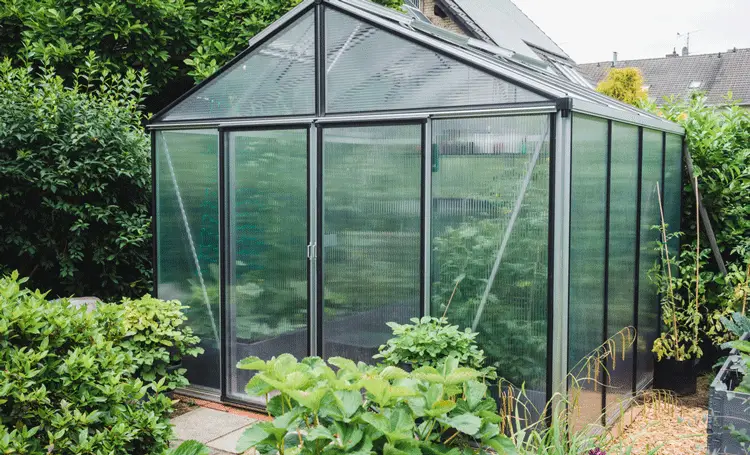
Accuracy Checks
Greenhouse thermostats lose accuracy over time owing to the accumulation of dirt and dust on the sensor. They should be run through a quality or accuracy check once a year.
- Clean the sensor coil and exposed connections off any dust.
- For 10 minutes, set the dial to below room temperature.
- Slowly raise the temperature setting until the heater turns on.
- The reading must match on an accurate wall or digital thermometer.
Final Thoughts
Selecting the best greenhouse heating system depends on your greenhouse size, the amount of heating required, and the type of plants.
With the right greenhouse heater, you’ll be able to grow plants all year long by maintaining optimal temperatures and preventing frost during the winter months. This is going to make you one happy plant parent, just like me!
